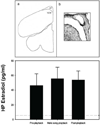Establishing regional specificity of neuroestrogen action
- PMID: 24726987
- PMCID: PMC4348095
- DOI: 10.1016/j.ygcen.2014.03.043
Establishing regional specificity of neuroestrogen action
Abstract
The specificity of estrogen signaling in brain is defined at one level by the types and distributions of receptor molecules that are activated by estrogens. At another level, as our understanding of the neurobiology of the estrogen synthetic enzyme aromatase has grown, questions have emerged as to how neuroactive estrogens reach specific target receptors in functionally relevant concentrations. Here we explore the spatial specificity of neuroestrogen signaling with a focus on studies of songbirds to provide perspective on some as-yet unresolved questions. Studies conducted in both male and female songbirds have helped to clarify these interesting facets of neuroestrogen physiology.
Keywords: Aromatase; Estradiol; Neuroestrogen; Neurosteroid; Songbird.
Copyright © 2014 Elsevier Inc. All rights reserved.
Figures

References
-
- Acharya KD, Veney SL. Characterization of the G-protein-coupled membrane bound estrogen receptor GPR30 in the zebra finch brain reveals a sex difference in gene and protein expression. Dev Neurobiol. 2012;72:1433–1446. - PubMed
-
- Ball GF, Bernard DJ, Foidart A, Lakaye B, Balthazart J. Steroid sensitive sites in the avian brain: does the distribution of the estrogen receptor alpha and beta types provide insight into their function? Brain Behav Evol. 1999;54:28–40. - PubMed
-
- Balthazart J. Hormonal Corrleates of Behavior. In: Farner DS, King James R, Parkes Kenneth C, editors. Avian Biology. New York: Academic Press; 1983. pp. 221–365.
-
- Balthazart J, Ball GF. Is brain estradiol a hormone or a neurotransmitter? Trends Neurosci. 2006;29:241–249. - PubMed
Publication types
MeSH terms
Substances
Grants and funding
LinkOut - more resources
Full Text Sources
Other Literature Sources

